|
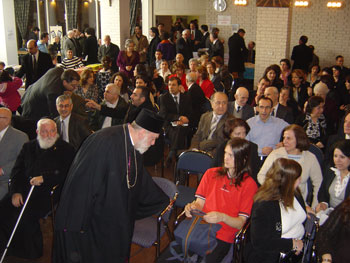 Beth Nahrin Bokmässa - Stockholm, March 15-16, 2008
Södertälje is a Swedish town about 30 km south of Stockholm. Some decades ago Assyrians, Aramaic speaking Christian immigrants from the region of Tur Abdin in SE Turkey, found a new home in the Södertälje area. This Assyrian or Suroyo community nowadays numbers at least twenty thousand souls and thus Södertälje got its popular nickname: Syriantälje. ‘In a way it looks as if we have taken over the place,’ says Simon Oguz, my local guide. ‘Swedish who keep living among us here even feel the need to pick up some Aramaic to make themselves understood.’
Civil War in Södertälje
A large square outside the centre of Södertälje is called St Afrem Syrerns Plan. It refers to the Oriental Christian saint Mor Efrem the Syrian. The sign with his name in Swedish and Aramaic is damaged. Hard to tell if this vandalism has any recent link with the troubles that broke out in the late seventies of the previous century.
In those days gangs of Swedish right-wing youngsters, known as raggare, started riots in Södertälje. This provoked counterattacks by young Assyrians, who defended their territory. Violence escalated and the riots went on for several weeks. ‘To this day that period is known in Swedish media as the Södertälje Civil War,’ Simon says. According to him Assyrian resistance broke the backbone of the raggare gangs and later on such large scale racist outbursts didn’t occur anymore in Södertälje.
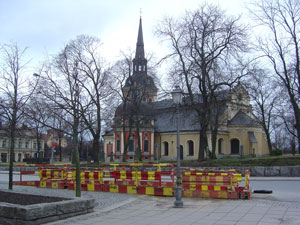 Södertälje Central Square
Time also mentioned that the Swedish government had tried to break up the Assyrian ghettos in the Stockholm region before the violence started, but the Assyrians wouldn’t give up their traditional way of living in clans and simply moved back together. The riots that broke out in 1977 were denounced by Andrew Young, the first African-American ambassador to the United Nations. White extremists were to blame, Young declared in his comment on the events and he infuriated the Swedes by calling them 'terrible racists'.
New Houses and Old Habits
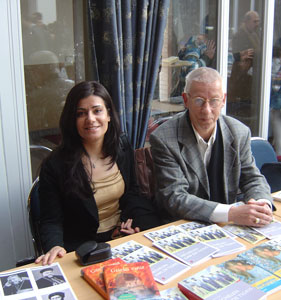 Assyrian Book Exhibition - Stockholm 16.03.2008
Simon drove me around in his car. We visited a spacious housing estate still under construction. Assyrian or Suroyo families –what’s in a name – were building large houses there. Too large and too luxurious in fact for Swedish standards. These new houses resembled the even larger three-storeyed marble palaces erected by Suroyo refugees from the village of Kafro in Tur Abdin, when they returned from Germany to their homeland in SE Turkey and started rebuilding the village. In Turkey such pomp and circumstance may work, in Sweden it could cause a problem.
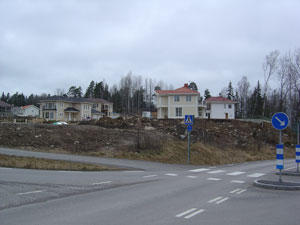 Södertälje - Assyrian housing estate under construction
Södertälje is now a quiet place, too quiet perhaps, with loneliness and nostalgia lurking just behind the green scenery and the low skyline. I looked at the grey clouds. An unusually soft winter. ‘No snow at all this year and temperature hardly dropped below zero,’ Simon said. The climate is changing, the warming up of the earth, so it seems. I wonder if it will lead to warm and sunny sunsets for the old generation of the Assyrian immigrants in Södertälje.
Life goes on. We were present when a Suroyo baby was baptized under the golden dome of the magnificent Saint Peter and Paul’s church, close to Södertälje. A few hours before that happy event we had visited the wholesale store of an Assyrian friend of Simon. It was a kind of supermarket for goodies and sweets. Swedish children had come on their own or with their parents to fill plastic bags with the brightly coloured sweet stuff. Simon gave me a large box, filled to the brim with these goodies. ‘For your grandchildren,’ he said. It was a welcome present from his friend, the shopkeeper, and refusing it was of couse out of the question. So I didn’t mention anything about spoiling the first teeth of my dearly beloved grandchildren and I thankfully accepted the gift.
Assyriska Soccer
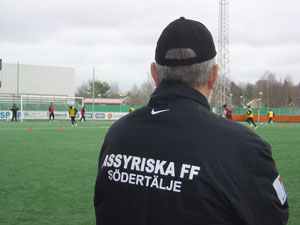 Assyriska FC - Suroyo Soccer in Södertälje
After 2004 things got worse for Assyriska. The club fell back to a lower division in the Swedish soccer competition and nowadays the team is struggling hard to avoid further degradation. They keep playing in their modern stadium, where the glory of the great days is still somewhat visible for those who want to see it. I am one of them.
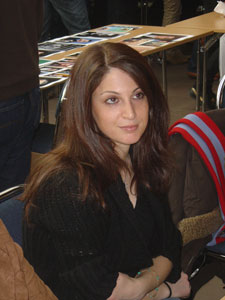 Attending the Beth Nahrin Bokmässa
The age-old religious and ethnic disputes that split up the minorities of Aramaic speaking Christians in SE Turkey and other regions in the Middle East are reflected in the two names. Names that divide them in the name of Assyrian nationalism or Syrian-Orthodox belief. It seems to be their fate. And yet, they all support the Assyriska soccer team when it plays well and they all watch Suroyo TV, their own Södertälje based satellite channel. They are good folk, experts in survival under northern skies in Sweden, far away from their lost Assyrian homeland.
Text and pictures - A. Thiry
|

 Diaspora
Diaspora  Assyrians in Sweden
Assyrians in Sweden

 Diaspora
Diaspora  Assyrians in Sweden
Assyrians in Sweden